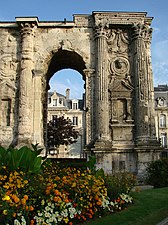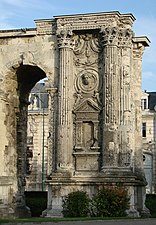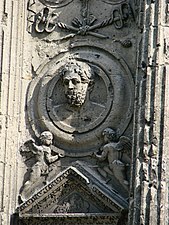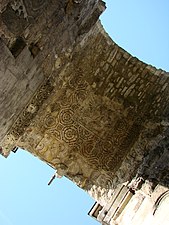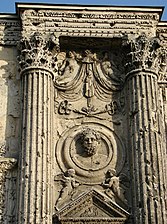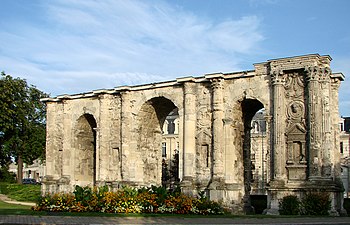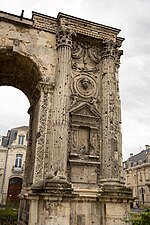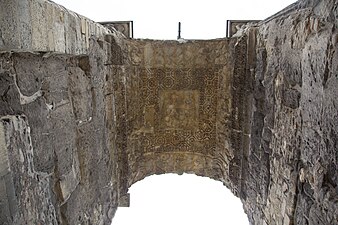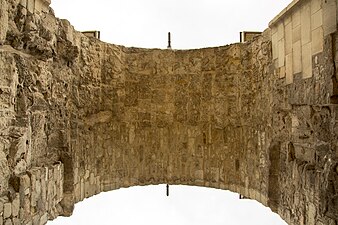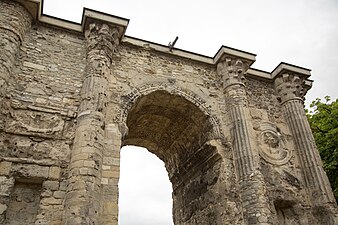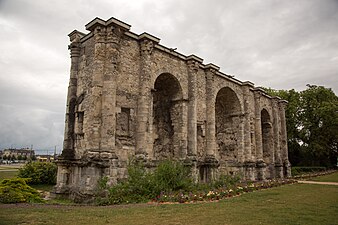Porte de Mars
The Porte de Mars is a Gallo-Roman triumphal arch in Reims (France).
history
The building probably dates from the 3rd century . It is one of the most impressive monuments of the Roman era north of the Alps and is the city's oldest stone monument. Its name derives from a nearby temple which was dedicated to the god of war Mars . The structure is still in situ today . Until 1544 the arch served as a city gate and was part of the ancient wall that enclosed the city. In 1817 the surrounding buildings were put down to better bring out the arch. The square became the Place de la République of Reims.
Around the year 200 the Gallo-Roman period reached its peak in the city. Four gates connected the two main axes of the city, the via cardo and the via decumanus . Under these gates was the Marstor. Later this gate was integrated into the episcopal city wall.
description
The triumphal arch is 13 meters high, 6.4 meters deep and 32 meters wide, making it the widest of its kind in the world. The inscriptions and design elements on its outside and the inside of the three passages are rich in detail. The underside of the arches, now heavily eroded, offer a rare and interesting depiction of a Gallic harvester. Deep furrows under the central arch indicate that the car traffic was handled there, while pedestrians walked on each side. This arch marks the entrance to the city center, as we know today that the city extended far beyond it to the north. From the Porte de Mars the Roman roads went to Soissons and Bavay, Laon and Boulogne.
The Roman Durocortorum (Reims) was a wealthy city and able to erect great monuments. It is believed that the city's residents built the triumphal arch in honor of Emperor Augustus out of gratitude because the Roman garrison built solid roads through the city. The builders wanted to show how Reims benefited from its alliance with the Romans.
Corinthian capitals are attached to the outside of the arched pillars and end below the archivolt . Various sacrificial scenes are shown in the area above the archivolt.
Central arch
In the vault of the central arch rural monthly pictures are depicted, which depict the contemporary riches of the country: grain production, vines and cattle breeding.
Different scenes depict the months of the farm work year:
- June: Sexual reproduction of farm animals
- July: haymaking
- August: harvest time for apples and crops
- September: plowing and hunting deer on horseback
- October: pressing the grapes
- November: Pig slaughter as a sacrifice
- December: Allocation to provisions
- As well as a man with four children, who represent the year and its four seasons
Eastern arc
Zeus fell in love with Leda . He approached her in the shape of a swan and impregnated her.
Western arch
The inside of the western arch is decorated with the scene in which Romulus and Remus are suckled by the she-wolf. According to legend, they were the children of the god Mars and the priestess Rhea Silvia .
literature
- Gilbert Charles-Picard : La Porte de Mars à Reims. In: Actes du 95e Congrès national des Sociétés savantes, Reims 1970. Section d'archéologie et d'histoire. Paris, 1974, pp. 59-93.
- François Lefèvre: Historique de la Porte de Mars 1980
- François Lefèvre: La Porte de Mars de Reims Groupe d'Etudes Archéologiques Champagne-Ardenne 1985
- Bernard Fouqueray: Les Portes Antiques de Reims May 1986
- François Lefèvre: Porte de Mars Patrimoine culturel de Reims: Période Gallo-Romaine, CRDP, 1994.
- François Lefèvre: Calendrier des Saisons de la Porte de Mars Patrimoine culturel de Reims: Période Gallo-Romaine, CRDP, 1994.
- Jean-Marie Pérouse de Montclos: Le guide du Patrimoine: Champagne-Ardenne , Hachette, Paris 1995, ISBN 2-85822-614-8 , p. 302.
- François Lefèvre: Nouvelle lecture du décor de la Porte de Mars de Reims. In: Études Marnaises 119, 2004, pp. 25–41.
Web links
Coordinates: 49 ° 15 '38.2 " N , 4 ° 1' 47.8" E



